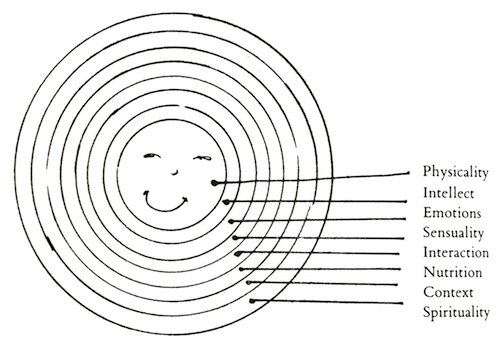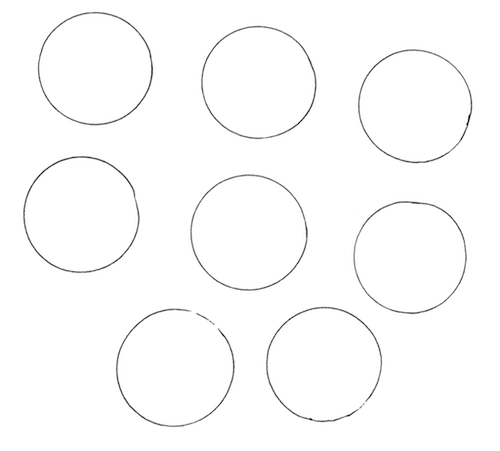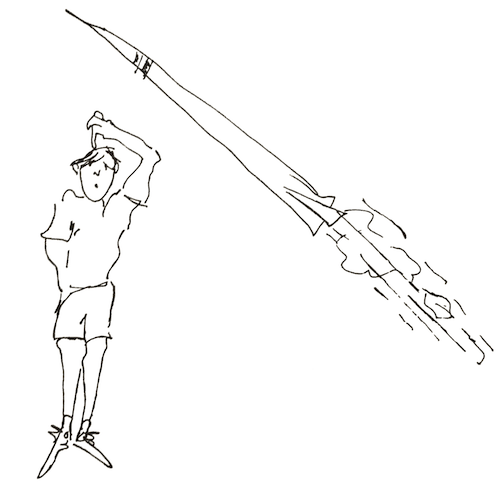5. Your Self Mandala
This chapter is aimed at further exciting you about yourself and, through your example, at exciting those around you, especially your family members, about being a human being and being alive.
I want to interest you in learning more about how your various parts work, and what a treasure you really are. Humans are wonderfully made.
To start, imagine that you are looking through spectacles that have eight lenses. Each lens reflects an essential part of yourself:
Your body —— your physical part
Your thoughts —— your intellectual part
Your feelings —— your emotional part
Your senses —— your sensual parts: eyes, ears, skin, tongue, and nose
Your relationship —— your interactional part
Your context —— your space, time, air, color, sound, and temperature
Your nutrition —— the liquids and solids that you ingest
Your soul —— your spiritual part
Through the first lens, you will see the physical body with all its parts and systems. If you have never seen the inside of a human body, and most of us have not, find a good anatomy book in which you can see pictures of your bones, muscles, internal organs, together with all the different systems (respiratory, circulatory, etc.). Let yourself be awed and amazed at how wonderfully your body is engineered and what a treasure house of resources it contains. If you can find a videotape of this in the library, so much the better.

Apply this information to your own body. Are you, its owner, meeting its needs? Are you listening to it? It will tell you when you are tired, hungry, or over-stressed, or alert you to any part of you that needs special care.
The second lens shows your intellect, the cognitive part of your brain. This lens tells you about the information you take in, the thoughts you have, and the meaning you give them. From this cognitive and rational part, you can get answers to such questions as, “What do I understand? How do I learn new things? How do I analyze situations and solve problems?”
We are just beginning to learn about the fantastic feats of learning that our brains and minds can accomplish. I have listed some interesting books on this subject and related subjects in the bibliography.
The third lens is that of your emotions, your feelings. How free are you to recognize and acknowledge them? What restrictions do you put on your feelings? How do you express them? Can you be friendly to all your feelings, knowing that how you deal with them makes the difference? All feelings are human. They bring texture, color, and sensitivity to life. Without feelings, we would be robots. Your feelings show you your current temperature. Your feelings about these feelings show you where your self-worth is in relation to your feelings.
The fourth lens lets you know how you sense yourself. What is the physical condition of your sense organs? What freedoms do you give yourself to look, hear, touch, taste, and smell? What restrictions do you place on these wonderful parts of yourself? Can you allow yourself to let the restrictions go? Many of us were taught as children that we could only look at, touch, or listen to certain things. That often resulted in limiting our use of our senses. To acknowledge, honor, and fully and freely use our senses is the main way we interact with the outside world and stimulate ourselves internally. We need a lot of sensual food to create interest for our senses. In turn, this bathes the inner psychological self.
The fifth lens shows how you interact with the people in your world. Your interaction shapes the nature of your relationships. How do you evaluate the quality of your various relationships? How do you use your power? Do you give it away and become a victim? Do you use it to become a dictator? Do you use it to develop harmony within yourself and with others, thus becoming an empowering leader? In other words, do you use your power to nurture yourself or others, or to threaten? Do you team up with family members or others to do things together? Do you have fun, make jokes, and generally use good humor to make your life and that of others lighter and happier? Remember that humor and love are two very powerful healing forces.
The sixth lens has to do with nutrition. What kind of food and drink do you put into your body? Do you understand that you need good nutrition to feed your body? Current research shows a relationship between what one eats and drinks and how one feels and acts.
The seventh lens has to do with your context. This refers to the sights and sounds, the feel of things, the temperature. the light, the color, the quality of air, and the space where you live and work. Each of these factors has an important effect on your life. For example, the kind of light and the amount of light have a great deal to do with your health. We are also beginning to see a relationship between color, sound, and music, and what happens in the human body.
The eighth lens has to do with your spiritual connection. This represents your relationship to your life force. How do you regard your life? Do you honor it? Do you use your spiritual connection in your daily life?
Each of these eight parts performs a different task and can be understood separately. However, within a person, no part can function by itself. All parts are interacting with all other parts all the time. This is another way of saying that whatever happens to one part affects all others.
The following figure shows the eight parts as though they were separate discs. All of them come together at the center which is represented by the Self, which is YOU.
Imagine each disc as a different color. You might even want to make one. just cut out eight discs from colored paper, each one graduated in size.
Place your picture in the center, on a separate disc. You can call this your Self Mandala. Give yourself time to think about what you know and how you use your various parts. For example, you have very likely already experienced what happens to you when you eat something to which you are allergic, or when you are faced with criticism from someone, or are angry and cannot express it. These negative outcomes are manifestations of how our parts behave.

Considering our parts as interacting with one another was a foreign concept, especially to Western medicine, until forty years ago. Then physicians began to realize that inharmonious interaction among mind, emotion, and body was a large factor in the development of ulcers. This produced a new specialty, named psychosomatic medicine. Following the line of reasoning that led to this finding, it is equally possible that harmonious interaction among these three parts leads to health.
This was a wonderful start. We are now learning that all eight parts influence and are influenced by each other. We need to learn as much as we can about how this works, we are only beginning to have technology that helps us understand this process. For instance, we can now monitor the effect of negative thoughts on chemical responses in the body.
Learn all you can. Articles about some of our technology read like science fiction. Equally fantastic developments are under way in science, particularly physics.
A whole new world of information is opening up. Today we hear a lot about stress and its negative effects on the body, mind, and emotions. Now that you know these inter-relationships exist, you can learn how to observe yourself and what happens to you. You will begin to see many things that you were unaware of before.
As we increase our knowledge of ourselves, developing and maintaining health becomes paramount. To create the best possible scenario for our total health and well-being we would:
Give our body good care, attention, exercise, and love.
Develop our intellect through learning how we learn and surrounding ourselves with stimulating ideas, books, activities, learning experiences, and opportunities to engage in dialogue with others.
Give ourselves permission to become so friendly with our feelings that they work for us instead of against us.
Develop our senses, learn about their care, and think of them and use them as vital avenues to bring things into ourselves.
Develop harmonious ways of problem-solving, nurturing, and conflict resolution; and develop congruent and healthy relationships.
Learn what our nutritional needs are and provide for them; remember that each person’s body is unique. Eating strawberries gives one person hives; another will have a taste treat.
Provide the place where you live and work with the kinds of sights, sounds, temperature, light, color, quality of air, and space that more fully support life.
Engage yourself with what it means to be alive, to be a part of the universe, to fully manifest yourself and to know that there is a life force outside yourself.
As we pay more attention to our total health, we will certainly arrive at a more joyous, responsible, and effective life. Perhaps even a greater reward will be developing a closer connection between ourselves and our planet. We are at this time in the shadow of nuclear weapons which could herald the end of our existence on the planet as we know it today.
On a television program not so long ago, I saw a picture of a nuclear weapon and, within another few minutes, a picture of a space ship launching. The two were remarkably similar in their forms but very different in their goals. One was to destroy, the other to discover.

We are blessed with fine endowments as human beings. It remains for us to choose how we will use these resources. I believe we have the energy, intelligence, information, will, love, and technology that can help us make the kinds of choices that will further our evolutionary process. Human beings do have a higher nature. By really knowing and appreciating ourselves in all our parts, we can reach that higher nature.